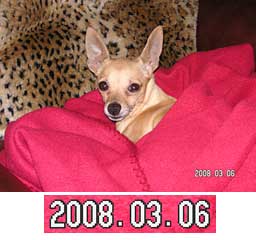2008: I’ve been into photography since the mid-1970s, and I’ve worked in camera stores several times over the intervening years. For me, one of the banes of good enlargements is dates in photos. I’ve seen more nice candids, animal shots, sunsets, etc. that would make excellent large prints – but they have a big, ugly date permanently etched into the negative.
You’d think we could have avoided that with digital photography, as each image records the date and time when it is taken, but camera makers just digitally duplicated the same kind of date imprinting they used with film cameras. The date is a permanent part of the photograph.
We have a couple digital cameras at home. The “good one” is the 8 MP Kodak EasyShare P880 that my wife and I bought a few months before our honeymoon. (Tip: Never buy a camera just before leaving on a trip. Give yourself some time to get familiar with it.) It’s got a good zoom range, the equivalent of 24-140mm on a 35mm SLR, and the wide-angle coverage is great for scenics.
The other is a Konica Minolta Dimage X50, which I bought a few years ago because I wanted something smaller than my Digital Rebel. It’s got a 3x zoom and easily fits into a pocket. And until today, I’d never even turned on the date feature.
To Date or Not to Date?

Date in photo: Kodak EasyShare P880
My wife and I have different philosophies of photography. I take pictures, store the photos in their envelopes or the digital files on my hard drive, share a few with others, and blow up some of the best to 8 x 10 for display.
She takes pictures and scrapbooks them. For her, it’s very important to have the date on every photo. That’s great for snapshots, but I hate seeing big, blocky yellow digits on my enlargements (left), so I try to remember to turn dates off for scenics and then back on for her.
That’s what our Kodak EasyShare does. It takes great 8 MP photos, but those dates are butt-ugly. There has to be a better way.

Date in photo: Dimage X50
The Dimage X50 does a much nicer job with dates. For one, the font isn’t butt-ugly but almost attractive. The numbers are white with black surrounding them, so the dates will show up on even a yellow, white, or black background. This is a big step in the right direction!
But there’s another problem with dates in your photos: Verticals. Whether you rotate the camera 90° to the right or to the left, the date isn’t going to be horizontal or at the bottom of your picture. It’s sideways – no different from what film cameras did.

Digital photo with vertical date.
Why doesn’t the camera sense that it’s sideways? The date is applied to the image, so there’s no reason it couldn’t be written in the lower right-hand corner of vertical photographs.
A Better Way
I’ve been thinking for a long time that there has to be a better way than just plopping the date in a fixed location using a fixed color. After all, the date and time are linked to the photo when it’s taken. Why can’t you decide after the fact whether you want the date in your picture, where you want it, and what color you want it to be?
In fact, why not save the photo without imposing the date on it? Why not allow the user to add the date and/or time stamp at any time in the future, since that data is already part of the photograph’s digital file?
Here’s my proposal: Set aside a fixed number of bytes to store the time and date that the photo was originally shot, along with time zone information. Maybe use the Unix time scheme for this. Next include a byte that tells whether the photo is horizontal, vertical (turned right or turned left), or upside-down. The next two bytes will determine where that date stamp appears in the printed photo.

Digital photo with a good looking date stamp.
Then use three bytes to store 24-bit color data (the same color space used by digital cameras and computers). Another byte could tell whether the date should have a shadow or reverse shadow behind it to help it stand out from the background. Use one byte for the date format (YYYY-MM-DD, etc.). Create a list of standard fonts and use one byte to note the typeface. And finally, include one byte that tells the printer whether it should include the date or not.
Make this a free industry standard that can be used by camera makers, in photo kiosks, and in Photoshop and whatever program you might use to view and edit your photos.
Let’s get rid of ugly dates on digital photos.

